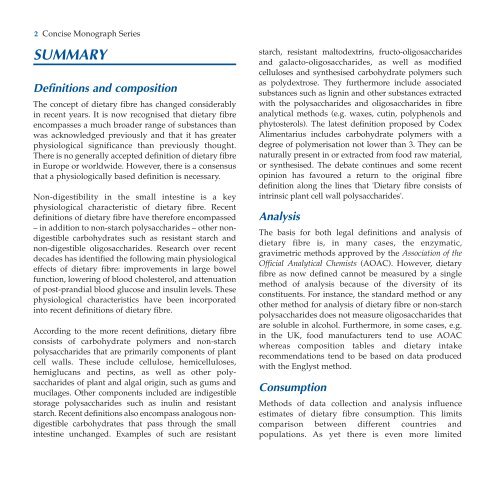Dietary Fibre - ILSI Argentina
Dietary Fibre - ILSI Argentina
Dietary Fibre - ILSI Argentina
Create successful ePaper yourself
Turn your PDF publications into a flip-book with our unique Google optimized e-Paper software.
2 Concise Monograph Series<br />
SUMMARY<br />
Definitions and composition<br />
The concept of dietary fibre has changed considerably<br />
in recent years. It is now recognised that dietary fibre<br />
encompasses a much broader range of substances than<br />
was acknowledged previously and that it has greater<br />
physiological significance than previously thought.<br />
There is no generally accepted definition of dietary fibre<br />
in Europe or worldwide. However, there is a consensus<br />
that a physiologically based definition is necessary.<br />
Non-digestibility in the small intestine is a key<br />
physiological characteristic of dietary fibre. Recent<br />
definitions of dietary fibre have therefore encompassed<br />
– in addition to non-starch polysaccharides – other nondigestible<br />
carbohydrates such as resistant starch and<br />
non-digestible oligosaccharides. Research over recent<br />
decades has identified the following main physiological<br />
effects of dietary fibre: improvements in large bowel<br />
function, lowering of blood cholesterol, and attenuation<br />
of post-prandial blood glucose and insulin levels. These<br />
physiological characteristics have been incorporated<br />
into recent definitions of dietary fibre.<br />
According to the more recent definitions, dietary fibre<br />
consists of carbohydrate polymers and non-starch<br />
polysaccharides that are primarily components of plant<br />
cell walls. These include cellulose, hemicelluloses,<br />
hemiglucans and pectins, as well as other polysaccharides<br />
of plant and algal origin, such as gums and<br />
mucilages. Other components included are indigestible<br />
storage polysaccharides such as inulin and resistant<br />
starch. Recent definitions also encompass analogous nondigestible<br />
carbohydrates that pass through the small<br />
intestine unchanged. Examples of such are resistant<br />
starch, resistant maltodextrins, fructo-oligosaccharides<br />
and galacto-oligosaccharides, as well as modified<br />
celluloses and synthesised carbohydrate polymers such<br />
as polydextrose. They furthermore include associated<br />
substances such as lignin and other substances extracted<br />
with the polysaccharides and oligosaccharides in fibre<br />
analytical methods (e.g. waxes, cutin, polyphenols and<br />
phytosterols). The latest definition proposed by Codex<br />
Alimentarius includes carbohydrate polymers with a<br />
degree of polymerisation not lower than 3. They can be<br />
naturally present in or extracted from food raw material,<br />
or synthesised. The debate continues and some recent<br />
opinion has favoured a return to the original fibre<br />
definition along the lines that '<strong>Dietary</strong> fibre consists of<br />
intrinsic plant cell wall polysaccharides'.<br />
Analysis<br />
The basis for both legal definitions and analysis of<br />
dietary fibre is, in many cases, the enzymatic,<br />
gravimetric methods approved by the Association of the<br />
Official Analytical Chemists (AOAC). However, dietary<br />
fibre as now defined cannot be measured by a single<br />
method of analysis because of the diversity of its<br />
constituents. For instance, the standard method or any<br />
other method for analysis of dietary fibre or non-starch<br />
polysaccharides does not measure oligosaccharides that<br />
are soluble in alcohol. Furthermore, in some cases, e.g.<br />
in the UK, food manufacturers tend to use AOAC<br />
whereas composition tables and dietary intake<br />
recommendations tend to be based on data produced<br />
with the Englyst method.<br />
Consumption<br />
Methods of data collection and analysis influence<br />
estimates of dietary fibre consumption. This limits<br />
comparison between different countries and<br />
populations. As yet there is even more limited

















